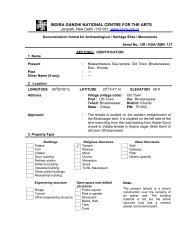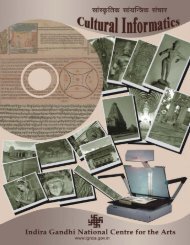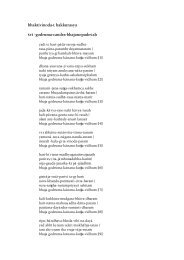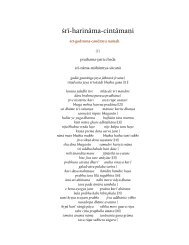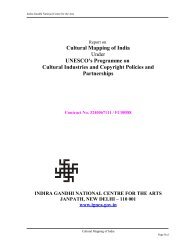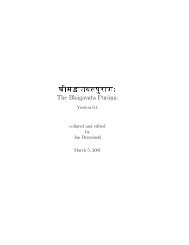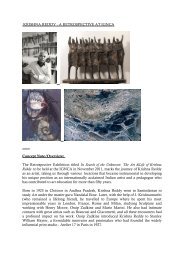sdfsf sf - Indira Gandhi National Centre for the Arts
sdfsf sf - Indira Gandhi National Centre for the Arts
sdfsf sf - Indira Gandhi National Centre for the Arts
Create successful ePaper yourself
Turn your PDF publications into a flip-book with our unique Google optimized e-Paper software.
<strong>Indira</strong> <strong>Gandhi</strong> <strong>National</strong> <strong>Centre</strong> For <strong>the</strong> <strong>Arts</strong>, New Delhi, India<br />
This article speaks about at Hampi with special reference to <strong>the</strong><br />
findings of Neolithic culture at Mosalayyanagudda, near Vithala temple in<br />
Hampi area. The article also refers to o<strong>the</strong>r pre-historic sites near by Hampi<br />
and surrounding areas like Sanganakallu and Pikllihalu etc.<br />
Krishnappa M.V and Chennabassappa S. Patil, Ed. Vijayanagara<br />
Adhyayana.Vol.-5 and Directorate of Archaeology and museums, Mysore,<br />
1999, pp…...<br />
Articles presented in <strong>the</strong> seminar conducted during Festival at Hampi -<br />
98 articles pertaining to Hampi - like palaces, Malyavantha Raghunatha<br />
temple, VijayaVitthala temple and Sri Virupaksha temple. There are some<br />
articles regarding Vijayanagara empire, art and architecture of that period.<br />
Linda Witman Oscar Carlberg, Sheetrock Features West of <strong>the</strong> City Walls,<br />
[ms 1993].<br />
* * *<br />
Laura L. Junker, Morphology, Function and Style in Traditional Ceramics, A<br />
Study of Contemporary Pottery from Bellary District, Vijayanagara<br />
Progress of Research 1983-1984, Eds. M.S. Nagaraja Rao, Directorate of<br />
Archaeology and Museums, Mysore,1985, pp. 144-151.<br />
This article deals with ear<strong>the</strong>n pottery from Vijayanagara. The<br />
relationship between <strong>the</strong> morphology of pottery vessels and <strong>the</strong> functions <strong>the</strong>y<br />
serve in <strong>the</strong> households which purchase <strong>the</strong>m and <strong>the</strong> stylistic consistency of<br />
<strong>the</strong> pottery in producing certain morphological effects on functional classes<br />
are discussed.<br />
Lal. B.B. Indian Archaeology 1968 – 69, A Review, Archaeological Survey<br />
of India, New Delhi, 1971, pp.<br />
This article deals with <strong>the</strong> conservation works in and around Krishna<br />
Temple. Here <strong>the</strong> various measures taken <strong>for</strong> <strong>the</strong> conservation at Krishna,<br />
Vitthala and o<strong>the</strong>r temples are explained.<br />
Mark T. Lyatt, Chipped Stone Tools of <strong>the</strong> Vijayanagara Metropolitan Region<br />
Vijayanagara Progress of Research, 1987, Eds. D.V.Devaraj and<br />
Channabasappa S. Patil, Directorate of Archaeology and Museums, Mysore,<br />
1991, pp 85 to …..<br />
This article speaks about <strong>the</strong> raw material procurement, production,<br />
distribution, use, and discard of finished products. The siliceous materials in<br />
<strong>the</strong> <strong>for</strong>m of building stones, grinding stones, agricultural implements and<br />
chipped stone tools are important components of technological organisation of<br />
<strong>the</strong> society. The lithic technology played an important role, albeit minor, in<br />
<strong>the</strong> hinterland of <strong>the</strong> capital after <strong>the</strong> Vijayanagar period.<br />
Bibliography on Hampi – Archaeology Articles<br />
18



